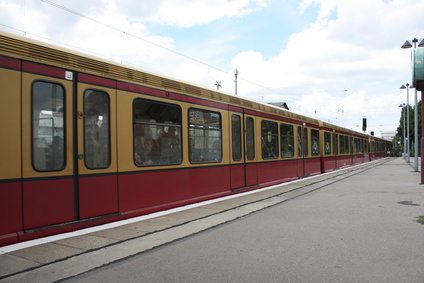In contrast to the subway of the capital, the Berlin S-Bahn (Berlin overground local train network) mostly runs above ground. In many regions of Berlin, the S-Bahn tracks even run on stilts above the city. This has the big advantage for the tourists that they see a lot of Berlin during the journey. Although the S-Bahn, unlike the bus, tram and underground, is operated by Deutsche Bahn, almost all tickets are valid for all means of transport. The Berlin S-Bahn network is over 300 km long and currently has 15 lines. This makes it the largest and longest S-Bahn network in Germany.

Picture: © Visual Concepts – Fotolia.com
The Berlin S-Bahn has a very long history. As early as 1838, the first train ran from Berlin to Potsdam, at that time of course pulled by a steam locomotive. The first electric trains were introduced around 1900. However, the great electrification of the network did not take place until after the 1st World War. Around 1930, the entire S-Bahn network was converted to electricity. In World War II, the S-Bahn was severely damaged, but only a few weeks in 1945 there were no S-Bahn services at all in Berlin. The construction of the Berlin Wall divided the S-Bahn into two parts, as did the entire city. After the end of the division of Germany, S-Bahn traffic resumed in the summer of 1990. Disused lines were gradually opened. Since 2009, many trains have been cancelled due to defects in vehicles, including insufficient maintenance of the coaches. Many Berliners think that the S-Bahn is in the biggest crisis since reunification. The situation is improving only very slowly at the moment (2011).
In 2011, the S-Bahn Berlin’s route network, which will be about 330 kilometres long, will have more than 160 stations. Part of the network (a good 20%) is located in the state of Brandenburg, the rest in Berlin. From the centre of the city, the lines run in a star shape to the outskirts of Berlin and the surrounding communities. However, there is also a circular railway on which S-Bahn trains run both clockwise and counterclockwise in the circle around Berlin (S41 and S42). Many a tourist drives a round to look at the outskirts of Berlin inexpensively (duration one hour). Most tourists take the S7 to the south-west. This line runs between the city centre, Wannsee and Potsdam. The most frequently used section of the Berlin S-Bahn is between Westkreuz and Ostkreuz. Several S-Bahn lines use these tracks with such well-known stops as Charlottenburg, Bahnhof Zoo, Hauptbahnhof Berlin, Friedrichstraße, Alexanderplatz or Ostbahnhof. All Berlin long-distance train stations have an S-Bahn connection. On weekends, the S-Bahn Berlin runs all night.
Almost all S-Bahn cars have the same colours in Berlin. They are ochre with red stripes. This makes them easy to distinguish from regional trains (often red) or underground trains (usually yellow). Several times other colours have been tested on the S-Bahn, as some people think that ochre is an old-fashioned colour on vehicles. However, they always returned to the old ochre and dark red colours.
See also article: Underground Berlin and trams in Berlin
Berlin Welcome Card: One ticket for local transport and sightseeingFor most tourists it is worth buying the Berlin Welcome Card. On the one |